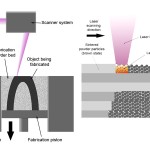
Selective Laser Sintering (SLS) is an additive manufacturing technology developed under sponsorship by the Defense Advanced Research Projects Agency (DARPA) and acquired in 2001 by 3D Systems.
SLS uses high power laser (for example CO2 laser) to fuse small particles of plastic, metal or ceramic powder together, layer-by-layer, to form a solid model. The system consists of a laser, part chamber, and control system.
The part chamber consists of a build platform, powder cartridge, and leveling roller. A thin layer of build material is spread across the platform where the laser traces a two-dimensional cross section of the part, sintering the material together. The platform then descends a single layer thickness and the leveling roller pushes material from the powder cartridge across the build platform, where the next cross section is sintered to the previous. This process is repeated one slice at a time until the part build height is completed.
Compared with other methods of additive manufacturing, SLS can produce parts from a relatively wide range of commercially available powder materials. These include polymers such as nylon (neat, glass-filled, or with other fillers) or polystyrene, metals including steel, titanium, alloy mixtures, and composites and green sand.
Because SLS requires the use of high-powered lasers, it is often more expensive (and potentially more dangerous) for use at home. However, there are several intrepid inventors out there who are working on their own versions of desktop SLS printers.